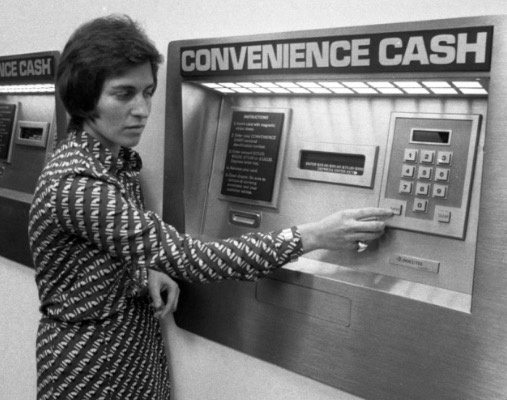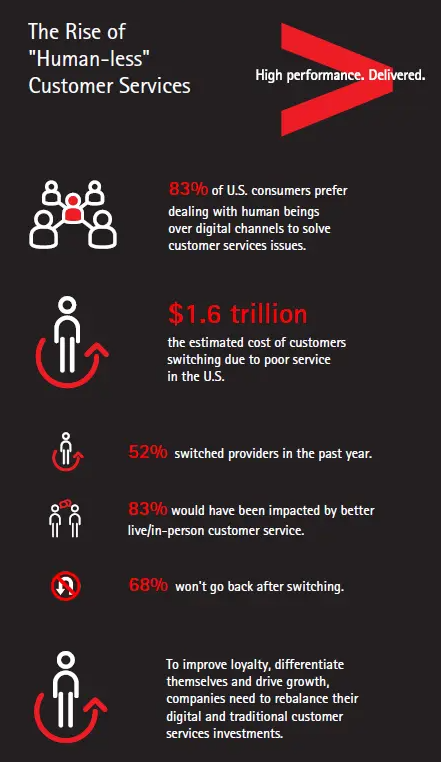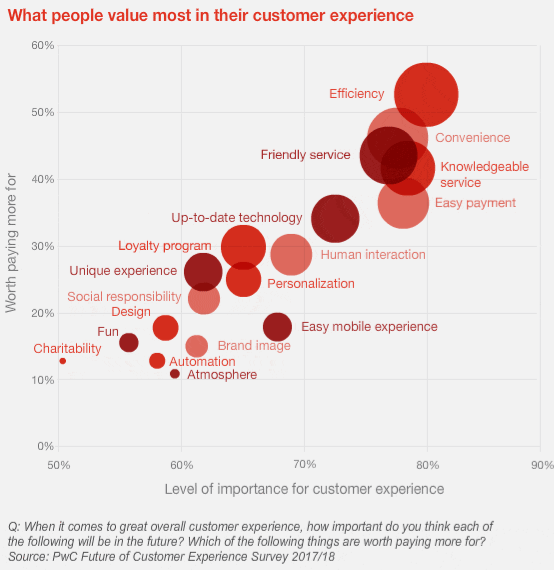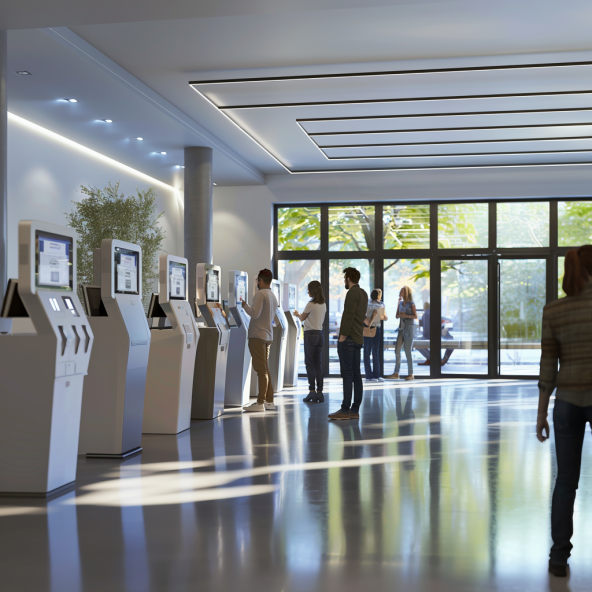Explore the transformation of customer experience in banking, discover present obstacles to in-branch services, and uncover technology’s role in overcoming these issues to significantly enhance customer journeys.
Table of contents:
- Evolution of Customer Experience in Banking
- Current Bottlenecks in In-Branch Banking Experiences
- Proposed Solutions for Common Customer Experience Challenges
- Technology as a Key Enabler for Enhanced Customer Experiences
In today’s rapidly evolving financial landscape, the customer experience (CX) has emerged as a critical differentiator for banks worldwide. Traditionally, banks prioritized transactional efficiency—focusing on processing deposits, withdrawals, and loans swiftly and accurately. However, as customer expectations have grown, this transactional focus is no longer sufficient.
Modern customers seek personalized, seamless experiences that cater to their individual needs across all channels of interaction. To stay competitive, banks must innovate continuously, ensuring that their services are not just transactions but memorable experiences. This means leveraging technology for personalized engagement, enhancing the customer’s journey from the moment they enter the branch to when they use digital services, and ensuring an effortless integration of physical and digital interaction points.
Evolution of Customer Experience in Banking
A Brief History of CX in Banking
The banking industry has undergone significant transformations over the past few decades. Initially, banking was a highly personal affair, with customers building relationships with local branch staff who knew them by name. The introduction of Automated Teller Machines (ATMs) in the 1960s revolutionized convenience, allowing customers to perform basic transactions without entering a branch. The rise of online banking in the late 20th century further shifted the paradigm, enabling customers to manage their finances from the comfort of their homes.

Shift to Customer-Centric Models
The proliferation of digital technologies and mobile devices in the 21st century has dramatically altered customer expectations. Today’s customers demand instant access to services, personalized interactions, and consistent experiences across all touchpoints. Banks are now shifting from product-centric models to customer-centric ones, focusing on understanding individual customer needs and delivering tailored solutions.
Growing Importance of CX in Banking
Customer experience is no longer just about satisfaction; it’s about building loyalty and advocacy in a competitive market. According to a study by Accenture, 81% of consumers would switch banks due to poor customer service. Banks that prioritize CX are better positioned to retain customers, attract new ones, and differentiate themselves from competitors that offer similar financial products.

Current Bottlenecks in In-Branch Banking Experiences
Challenges Faced by Customers at Branches
Despite advancements in digital banking, many customers still rely on branch visits for complex transactions and personalized assistance. However, several challenges hinder the in-branch experience:
Queue and Wait Times
Long queues remain a major frustration for customers visiting bank branches. Studies reveal that 73% of customers are likely to abandon their interaction if they wait more than five minutes. This statistic demonstrates the potential financial impact on banks due to customer churn caused by prolonged wait times.
Impersonal Interactions
In some branches, interactions can feel transactional rather than personalized. A study by Bain & Company found that over 70% of consumers expect banks to use personal data to deliver tailored experiences. When banks fail to meet these expectations, customer loyalty tends to erode, leaving customers feeling undervalued and disconnected.
Lack of Seamless Multi-Channel Service
Disjointed systems between online platforms and physical branches lead to repetitive processes, such as re-verifying information already provided digitally. This inconsistency can cause frustration as customers expect a unified experience. In fact, a report from Capgemini found that 76% of customers anticipate an omnichannel experience, and 59% expect on-demand, anytime customer service. When these expectations aren’t met, dissatisfaction can lead to increased customer churn.
Limited Accessibility
Branch hours may not align with customers’ schedules, and physical locations might not be easily accessible to all, especially those in remote areas or with mobility challenges. A survey by Which? found that 52% of disabled customers reported a negative impact on their ability to access banking services due to branch closures. This highlights the importance of ensuring branch operations are flexible and accessible to meet diverse customer needs.

Impact on Customer Loyalty
These bottlenecks not only frustrate customers but also erode trust and loyalty. In an era where alternative banking options—like fintech startups and online-only banks—are readily available, customers may choose competitors that offer more streamlined and personalized experiences. A study by PwC indicates that 32% of customers would stop doing business with a brand they loved after one bad experience.

Proposed Solutions for Common CX Challenges
To address these challenges, banks can implement several strategies:
Queue Management and Appointment Systems
Implementing automated queue systems and allowing customers to schedule appointments has become a common practice in most branches today. While effective in reducing wait times, these systems have proven their limits, as many customers still arrive without prior appointments. To address this, banks can deploy AI-powered avatar kiosks to handle routine requests much faster than at traditional counters. These kiosks streamline processes like account inquiries, basic transactions, and customer verifications, freeing up staff to focus on more complex and personalized interactions.

Enhanced, Personalized Service
Equipping teller counters with facial recognition screens allows banks to immediately recognize customers as they approach. This saves valuable time by pulling up customer profiles instantly, enabling staff to provide the most personalized experience right from the start. While facial recognition is widely appreciated for its convenience in digital banking – 64% of global banking customers either use or are willing to use it for account access—it also holds significant potential in physical branches. By integrating this technology, banks can streamline customer identification, reduce waiting times, and deliver tailored interactions that enhance overall satisfaction and loyalty.
Omnichannel Experience Integration
Developing unified platforms that synchronize data across all channels ensures a seamless customer journey, whether online or in-branch. For example, Bank of America’s “Robo-Branch” model allows customers to initiate loan applications or account openings digitally and seamlessly finalize the process in person. Similarly, Citi’s Smart Branches integrate self-service kiosks with digital tools, enabling smooth transitions between online and offline banking. Customers can start a process online and complete it in the branch without redundancy, enhancing convenience and efficiency.
Extended and Flexible Access Options
Offering extended hours, virtual consultations, or mobile branch services can significantly improve accessibility for customers with diverse schedules. For example, Standard Chartered’s virtual banking services provide customers with 24/7 access to personalized consultations through video calls. Similarly, PNC Bank’s Mobile Branches bring banking services to remote and underserved areas, ensuring customers can access essential services without traveling long distances. These efforts demonstrate how flexible access options can cater to modern customer needs, enhancing convenience and strengthening loyalty.
Staff Training and Empowerment
Investing in comprehensive training programs empowers employees to deliver exceptional service. For instance, JPMorgan Chase’s “Skill Training Academy” focuses on equipping branch employees with tools to personalize customer experiences effectively. Staff are trained to use real-time data insights, ensuring they can engage meaningfully with customers and provide tailored financial advice. This approach transforms routine transactions into opportunities for relationship building, enhancing both customer satisfaction and loyalty.
3. Technology as a Key Enabler for Enhanced CX
Overview of Technology’s Role
Technology is pivotal in bridging the gap between traditional banking and modern customer expectations. By integrating advanced solutions, banks can enhance operational efficiency, personalize services, and secure customer data – all essential components of exceptional CX. Technologies such as artificial intelligence (AI), the Internet of Things (IoT), and advanced analytics provide banks with tools to innovate and stay competitive.
Tech Solutions Addressing Current Challenges
1. Operational Workflow Automation
- Description: Automating routine tasks, such as data entry and transaction recording, enhances branch efficiency by minimizing manual effort and errors. Workflow automation tools simplify processes, ensuring operations run smoothly. This technology empowers staff to handle customer-facing responsibilities while back-end tasks are managed seamlessly in the background.
- Benefits: Automation reduces errors, accelerates processes, and improves resource allocation. According to McKinsey, automation in financial services can boost productivity by up to 30% within 18 to 24 months, demonstrating its potential to enhance efficiency. By handling repetitive tasks, staff can dedicate more time to personalized, value-added services.
- Example: Workflow automation tools can simplify complex processes, such as account opening and document verification. Solutions like Gaia Pulse reduce administrative workloads, enabling employees to complete tasks faster and focus on meaningful customer engagements, improving service quality and overall customer satisfaction
2. Seamless Customer Identification with Personalized Recommendations
- Description: AI-powered cameras integrated with real-time data analytics allow banks to recognize customers instantly as they enter a branch. This technology provides staff with immediate access to customer profiles, including transaction history and preferences. By streamlining access to these insights, banks can enhance the speed and quality of in-branch service.
- Benefits: Real-time insights enable bank staff to provide personalized assistance that meets individual customer needs. A study by Epsilon found that 80% of consumers are more likely to continue using services from businesses offering personalized experiences. In the context of bank branches, this means equipping staff with customer profiles to deliver tailored, efficient, and engaging interactions, reducing wait times and improving satisfaction.
- Example: AI cameras can identify returning customers and immediately provide staff with actionable insights, such as recent transactions or service preferences. Platforms like Gaia enable hyper-personalized interactions, allowing employees to make informed recommendations and proactively address potential concerns, enhancing the overall in-branch experience.

3. Space Utilization and Flow Analytics
- Description: Sensors and AI cameras analyze customer movement within branches, generating insights into how spaces are used. Tools like heat maps and flow analysis identify patterns, helping banks optimize layouts for better navigation and accessibility. This ensures smoother operations, reduced congestion, and a more comfortable environment for customers.
- Benefits: Optimized branch layouts significantly improve customer satisfaction and efficiency. Research indicates that 54% of customers value a branch layout that simplifies their visit, underscoring the need for thoughtful design. By reducing bottlenecks and ensuring ease of navigation, banks can create a positive and stress-free in-branch experience.
- Example: AI tools can analyze foot traffic to highlight areas of congestion, informing branch redesigns that prioritize accessibility. High-demand services can be relocated to improve convenience. For instance, placing ATMs near entrances or centralizing teller counters minimizes unnecessary movement and enhances customer satisfaction without disrupting operational efficiency.
4. AI-Driven Personalization with Enhanced Digital Platforms
- Description: AI and advanced mobile platforms together enable banks to deliver highly personalized and convenient experiences. AI algorithms analyze customer data to provide tailored recommendations and predict individual needs, while enhanced mobile and online platforms offer seamless access to banking services. By integrating these technologies, banks can ensure consistency across channels and meet the growing demand for personalized, digital-first experiences.
- Benefits: Combines the power of AI-driven personalization with the convenience of digital platforms to boost customer engagement, satisfaction, and loyalty. Tailored recommendations based on customer behavior can lead to a 6-10% revenue uplift, as noted by the Boston Consulting Group. Additionally, features like real-time transaction alerts, virtual customer service agents, and integration with digital wallets improve accessibility and engagement, reducing the need for in-branch visits.
- Example: The “customer brain” AI tool implemented by the National Australia Bank increased customer engagement by 40% by analyzing customer habits and predicting their needs. This demonstrates how AI can anticipate life events—such as a new job or home purchase – and recommend appropriate financial products. Enhanced mobile platforms complement this approach by enabling customers to access these personalized services conveniently, anytime, anywhere.
Conclusion
Transforming from transaction-focused to experience-driven, banks must address in-branch challenges and leverage technology to meet evolving customer expectations. By enhancing personalization, efficiency, and security, banks can foster loyalty and differentiate themselves in a competitive market.
Embracing innovations like AI and automation is not just beneficial but essential. The future of banking lies in seamlessly blending technological advancements with human-centric services to create exceptional customer experiences.
Interested in learning more? Talk to Neoma Sales today.







